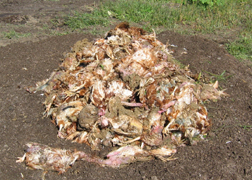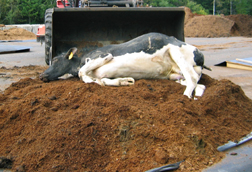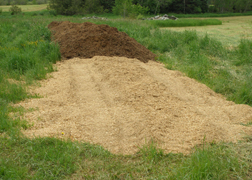Sustainable Carcass and Offal Management
Carcass Management: Economically and Environmentally Sustainable Practices
Mark Hutchinson, Associate Extension Professor, University of Maine Cooperative Extension, Orono, Maine (mhutch@maine.edu)
Dr. Bill Seekins, Agricultural Researcher, Maine Department of Agriculture, Food and Rural Services, Augusta, Maine
Mark. A. King, Environmental Specialist, Maine Department of Environmental Protection
George MacDonald, Director, Waste Management and Recycling, Maine State Planning Office
For information about UMaine Extension programs and resources, visit extension.umaine.edu.
Find more of our publications and books at extension.umaine.edu/publications/.

Any farm that raises livestock will eventually have dead stock. Death of livestock occurs for many reasons: natural causes, birthing complications, metabolic complications, diseases, environmental conditions to name a few. Managing mortalities is multifaceted depending on the cause of death, time of year, location of operation, and available disposal options. Traditional disposal options, burial, and rendering are becoming less attractive and practical because of higher cost and potential environmental impacts. Dragging carcasses into the woods has been banned or strongly discouraged in most states. Additional technologies such as alkaline hydrolysis, air curtain burners, and gasification are being developed but are capital investment intensive and not practical for small livestock operations. Composting is a biosecure, environmentally sound, and cost-effective management tool in many states. Burial, rendering, and compost are the three most commonly accepted practices for New England livestock producers. This is an overview of these management options.
Burial
Burial of mortalities has been an accepted practice for many years. The carcass is sequestered in the soil, out-of-sight and out-of-mind. However, burial has several issues of concern.
- The carcass will start to decay and release body fluids into the surrounding soil. Previously, no one paid attention to this because it was not visible. However, over time, 100% of the fluids have the potential to impact ground and surface water.
- The carcass often becomes anaerobic and little to no decomposition takes place.
- Winter burial is difficult.
- Digging a hole is both time-consuming and expensive.
- Locating a suitable burial site, especially on a small lot, can be difficult or, in some cases, not possible.
Rendering
Rendering is still a good option for areas that are serviced by a rendering company. However, in many areas of New England rendering is not an option. For those that have rendering services, costs have increased significantly because of transportation and regulation changes.
- A benefit of rendering is the ability to recycle the carcasses into useable products such as pet foods.
- However, new regulations on products have caused renderers to be more selective in the material they accept. Nerve tissue, including the brain and spinal column of some livestock, is not accepted for rendering.
- The cost to livestock owners may be prohibitive.
- Rendering is not available in many areas.
Compost

Compost provides a sustainable management tool for livestock disposal. Composting allows year-round economically and environmentally sustainable management of mortalities on the farm.
- Environmentally sound
- Groundwater/ leachate: A properly constructed compost pile will capture the body fluids and prevent odors. Eighteen inches of dry absorbent base material will capture body fluids. The fluids contain nitrogen which is used by the microbes in the composting process.
- If there is a discharge from a pile it is easily seen and can be managed before affecting surface and groundwater.
- Odors: Odors can typically be prevented by using a sufficient amount of cover material (generally two feet or more). This material acts like a biofilter to absorb potential odors.
- Vectors: Coyotes, turkeys, dogs, bear, crow, eagles, and other vectors are not attracted to a properly managed compost pile. There are no odors to attract them. If they find the piles and get curious, they quickly stop digging because of the pile temperatures. When the pile starts to cool off, there is no reason for vectors to dig in the pile. All or most of the soft tissue has been composted.
- Public perception: Most people walking by a carcass compost site would think that it was a manure stacking area. Manure stacking piles seem to be widely accepted as an agricultural practice.
- Use of material: The finished product can be field applied just like manure. Compost is a very good soil amendment. Piles can be spread as part of their nutrient management program in the spring or fall. In many areas, the product can also be sold for retail use.
- Biosecure: With a properly managed pile, appropriate microbial activity and pile temperatures, most pathogens are killed. Pile temperatures often exceed the recommended minimum of 131° F. Keeping the mortalities on the farm also eliminates off-farm vehicles, such as rendering trucks, from entering the farm, reducing the potential to bring diseases onto the farm, and reducing the possibility of “off-farm” transmittal of disease.
- Winter composting is not difficult. Easier than burial in winter since it does not require digging in frozen soil. Base and cover materials will heat if properly prepared. Learning the “recipe” that works best on your farm is important. Site access is also important in winter and spring (snow drifts, mud).
- Cost: Low to moderate start-up and operating cost. Locating a site with proper access, soils, and buffers will keep cost low. Initial cost will increase significantly if site modifications are necessary, but the cost should be returned with less operation and site management time.
- Easy to accomplish:
 For many, it is a “set and forget system,” but better than the burial option in most cases. The piles of compost and carcasses are static piles, requiring little attention by the operator. It takes significantly less time than a traditional burial. Material is easily applied to crop land after four to six months.
For many, it is a “set and forget system,” but better than the burial option in most cases. The piles of compost and carcasses are static piles, requiring little attention by the operator. It takes significantly less time than a traditional burial. Material is easily applied to crop land after four to six months.
- Groundwater/ leachate: A properly constructed compost pile will capture the body fluids and prevent odors. Eighteen inches of dry absorbent base material will capture body fluids. The fluids contain nitrogen which is used by the microbes in the composting process.
For more information, visit these websites:
- Management of Animal Carcasses, Tissue & Related Byproducts: Connecting Research, Regulations, and Response
- Composting Animal Mortalities (PDF), Minnesota Department of Agriculture
- Cornell Waste Management Institute
- Emergency Livestock Mortality Composting in Iowa
Information in this publication is provided purely for educational purposes. No responsibility is assumed for any problems associated with the use of products or services mentioned. No endorsement of products or companies is intended, nor is criticism of unnamed products or companies implied.
© 2010
Call 800.287.0274 or TDD 800.287.8957 (in Maine), or 207.581.3188, for information on publications and program offerings from University of Maine Cooperative Extension, or visit extension.umaine.edu.
In complying with the letter and spirit of applicable laws and pursuing its own goals of diversity, the University of Maine System does not discriminate on the grounds of race, color, religion, sex, sexual orientation, transgender status, gender, gender identity or expression, ethnicity, national origin, citizenship status, familial status, ancestry, age, disability physical or mental, genetic information, or veterans or military status in employment, education, and all other programs and activities. The University provides reasonable accommodations to qualified individuals with disabilities upon request. The following person has been designated to handle inquiries regarding non-discrimination policies: Director of Institutional Equity and Title IX Services, 5713 Chadbourne Hall, Room 412, University of Maine, Orono, ME 04469-5713, 207.581.1226, TTY 711 (Maine Relay System).

